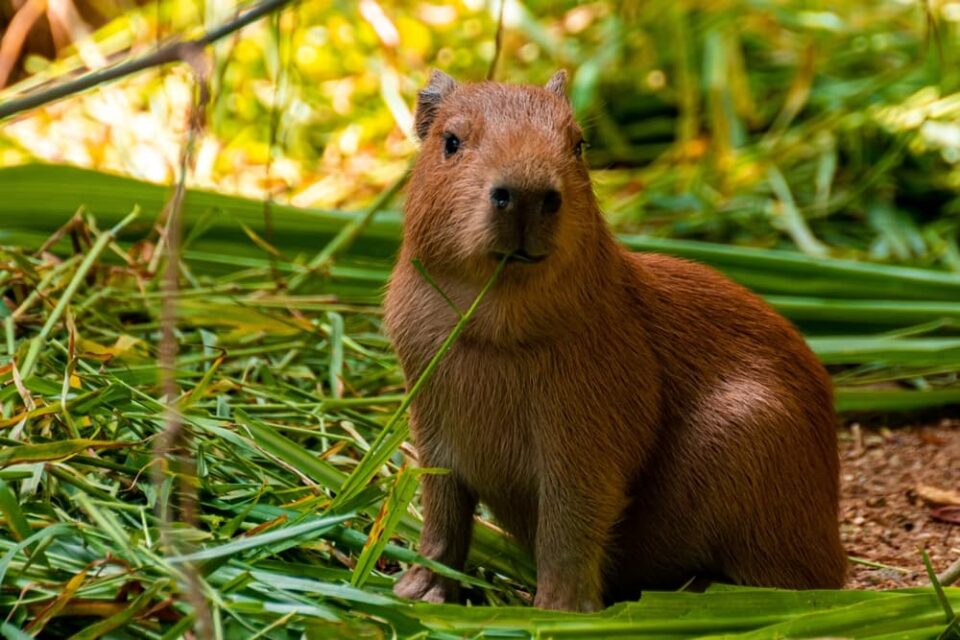Capybaras are herbivores, meaning their diet primarily consists of plants. But not all plants are safe for these gentle giants! Capybara-safe foods include fresh vegetables like carrots, leafy greens, and sweet potatoes, along with fruits like apples and melons, and a variety of grasses and hay.
In the wild, they can be found grazing on grasses, aquatic plants, and fruits. Their digestive system is designed to process large amounts of roughage, so it’s important to provide them with a diet that is high in fiber.
Capybaras also need to consume a lot of water to stay hydrated, so their diet should include foods with high water content as well. Understanding the capybara’s natural diet is crucial for ensuring that they receive the proper nutrition in captivity.
10 Capybara-Safe Foods and Treats
Here are 10 healthy and delicious treats that you can safely offer your capybara friends:
-
Timothy Hay: A staple in their diet, timothy hay provides essential fiber for digestion and helps keep their teeth trimmed. Offer unlimited access to fresh timothy hay every day.
-
Grasses: Capybaras are natural grazers, so access to fresh grass is important. Provide a variety of safe grasses like Bermuda, rye, or orchard grass.
-
Aquatic Plants: Mimic their natural diet with aquatic plants like water hyacinth, water lettuce, and duckweed. These can be offered in their pool or pond or as a separate treat.
-
Vegetables: Offer a variety of vegetables like carrots, sweet potatoes, squash, bell peppers, and leafy greens (romaine lettuce, kale). Wash and chop them into bite-sized pieces.
-
Fruits: Occasionally treat your capybara to fruits like apples, pears, melons, and berries. These are high in sugar, so offer them in moderation.
-
Commercial Capybara Pellets: These are formulated to meet their nutritional needs but should not be the sole source of their diet. Use them as a supplement to fresh foods.
-
Guinea Pig Pellets: In a pinch, high-quality guinea pig pellets can be offered as a temporary alternative, but consult your vet first.
-
Tree Bark: Capybaras love gnawing on bark, which can help keep their teeth healthy. Offer branches from safe trees like willow or aspen.
-
Commercial Rodent Treats: Choose treats specifically designed for rodents and offer them sparingly to avoid overfeeding.
-
Watermelon Rinds: A refreshing and hydrating treat, watermelon rinds are safe for capybaras and a great way to keep them cool on hot days.
Important Considerations:
- Freshness is key: Always offer fresh, clean food and water. Remove any uneaten food promptly to prevent spoilage.
- Variety is important: Offer a diverse selection of foods to ensure your capybara receives a balanced diet.
- Moderation is crucial: Don’t overfeed your capybara with treats, as this can lead to health problems.
- Consult your vet: If you have any concerns about your capybara’s diet, always consult with a veterinarian specializing in exotic animals.
Remember, a healthy and balanced diet is essential for your capybara’s well-being. By offering them a variety of safe and nutritious foods, you’ll ensure they live a long, happy, and healthy life as part of your family.
Conclusion
In conclusion, understanding the capybara’s diet is crucial for ensuring that they receive the proper nutrition in captivity. By providing them with a balanced diet of safe and nutritious foods, you can help support their digestive health and overall well-being.
Offering healthy treats in moderation can also provide enrichment for capybaras while still being mindful of their sugar intake. Ultimately, maintaining a balanced diet is essential for the health and well-being of capybaras, helping them thrive in captivity for years to come.


